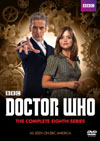DVD Extras for this story include:
This story quickly gains a focus, investigating two phenomena which, as we the audience can guess even faster than our two protagonists, are in fact nicely related to each other. This isn't quite the first time that the police box has shrunk in size, but it is the first time that it has done so without shrinking the TARDIS interior and its occupants along with it. The story gets a lot of mileage exploring the new possibilities and having fun with them. Excellent. Many permutations of 2-dimensional creatures interacting with our 3-dimensional world are also explored, with interesting results both visually and in terms of story mechanics and plot. In terms of what we get today, it is a bit limited to a monster-story formula, but there would be room to expand on the possibilities should they aim for other types of stories as well. I'm not sure that would happen under Steven Moffat's watch, so perhaps it is best to save the rest until someone else is in charge of the show. I especially like the way that the story beats escalate logically. As both protagonists and antagonists learn and gain new abilities, so both need to adapt their strategies to continue to counter each other. We don't have here the huge holes that plagued "Deep Breath" (story no. 247) or some of the other stories this season. Our humanoid characters' motivations also make total sense and are super easy to understand at all times, while the antagonists' motivations are held back and made mysterious in ways which continue to work all the way through, including in our afterthoughts. I'm very glad that part of the story included an attempt to communicate with the antagonists to search for a peaceful solution. It demonstrates our protagonists exploring possibilities and acting on good principles, while also giving us some nicely atmospheric scenes with very cool sounds. Great also that we don't actually hear a humanoid language emanating from these creatures, which keeps them alien and mysterious. Top notch. One very awesome dynamic that nearly had me applauding out loud was the way that Clara dealt with her friend Rigsy trying to sacrifice himself by driving the train. I love the way she cut through all the pseudo-swooning emotional arcs that usually surround self sacrifice beats like this, to instead think logically through the problem and find the win-win solution. So many other sci-fi stories could take a lesson from this, especially Moffat's own disaster "The Angels Take Manhattan" (story no. 235). Writer Jamie Mathieson earns a HUGE amount of respect from me for including such a smart move, and presenting it with such unmistakeable logic and triumphant dramatic overtones. Sweet. If there's a caveat anywhere in the story, it's that it appears to be a bit of deus ex machina that ends this sequence by dropping Clara and Rigsy off at random at the precise point where she could find the TARDIS, which is essential for the resolution of the story, but I think we can give the tale a bit of rope there...
An Exceptional ClaraI admit that when I first saw the Doctor get trapped in the TARDIS early on, I thought this must be the double-banked story of the season that would feature Clara almost exclusively while Capaldi filmed a different episode largely without her. However, I'd be hard pressed to identify that other episode, and indeed Capaldi does have a lot of scenes in this one, both in and out of the TARDIS. It certainly doesn't feel as though he gets stuck in the TARDIS to facilitate production scheduling as this one plays out, but rather simply because that is the interesting direction that the story naturally takes.Clara does get a good chance here to be and do all those things that we love in the Doctor. The script delivers those qualities in her actions and dialogue, while also drawing our attention to them, and Jenna Coleman pulls them off satisfyingly and entertainingly. The final moves really nicely demonstrate her ability to think on her feet, while giving the main local guest star a great contribution to make (good thing she kept him alive beyond his sacrifice moment), and also reserving a final move for the Doctor himself. Capaldi's Doctor also rises to the occasion for the final climax, giving us some really nice strong moments from his Doctor, while the TARDIS also gets some good moves and glory shots. The interior has been showcased particularly well during this episode, with some interesting and totally appropriate variations in lighting. All good. It is possibly also the most interesting bit of dialogue defining the twelfth Doctor's relationship with Clara all season (not to mention his opinion of himself) when he says to her, "You were an exceptional Doctor, Clara. Goodness had nothing to do with it." Classic. Does it mean anything when my favourite story of the season is one in which Clara takes over for most of the story and the twelfth Doctor spends most of his screentime in a supporting role? I'm not sure. His mind was involved with the main problem and active the whole time, with Capaldi emoting his theories brilliantly. His Doctor was still quite involved, but just left most of the physical running around to his able-bodied assistant. Only when he pulls the TARDIS into siege-mode near the end is her mettle truly tested independently of his influence. I'd have to say that this really was a good outing for both of them, and not just for Clara.
International Titles:Deutsch: "Hinter den Wänden"Magyar: "Egyenes Vonal"Français: "À plat"Русский: "Плоскость"Italiano: "I graffiti di Bristol"There's quite a variety in the international titles here, with the German "Behind the Walls", the Hungarian "Straight Line", the Russian "[Flat/Geometric] Plane", and the very different Italian "The Graffiti of Bristol". Perhaps the French are the most literal, in that they seem best poised to express the idea of an object becoming flat while also capturing the English connotation of electrical power going dead.
This story is available on DVD and Blu-ray:
Comments on this article are welcome. You may contact the author from this page:
|











